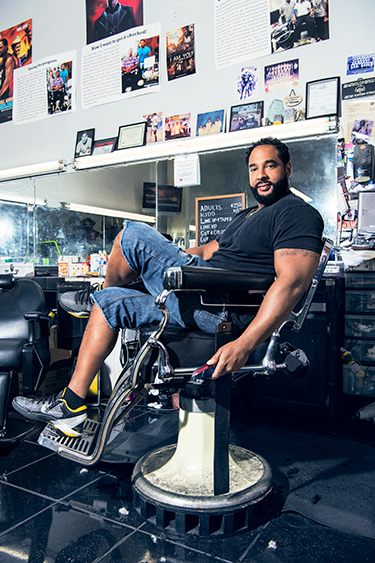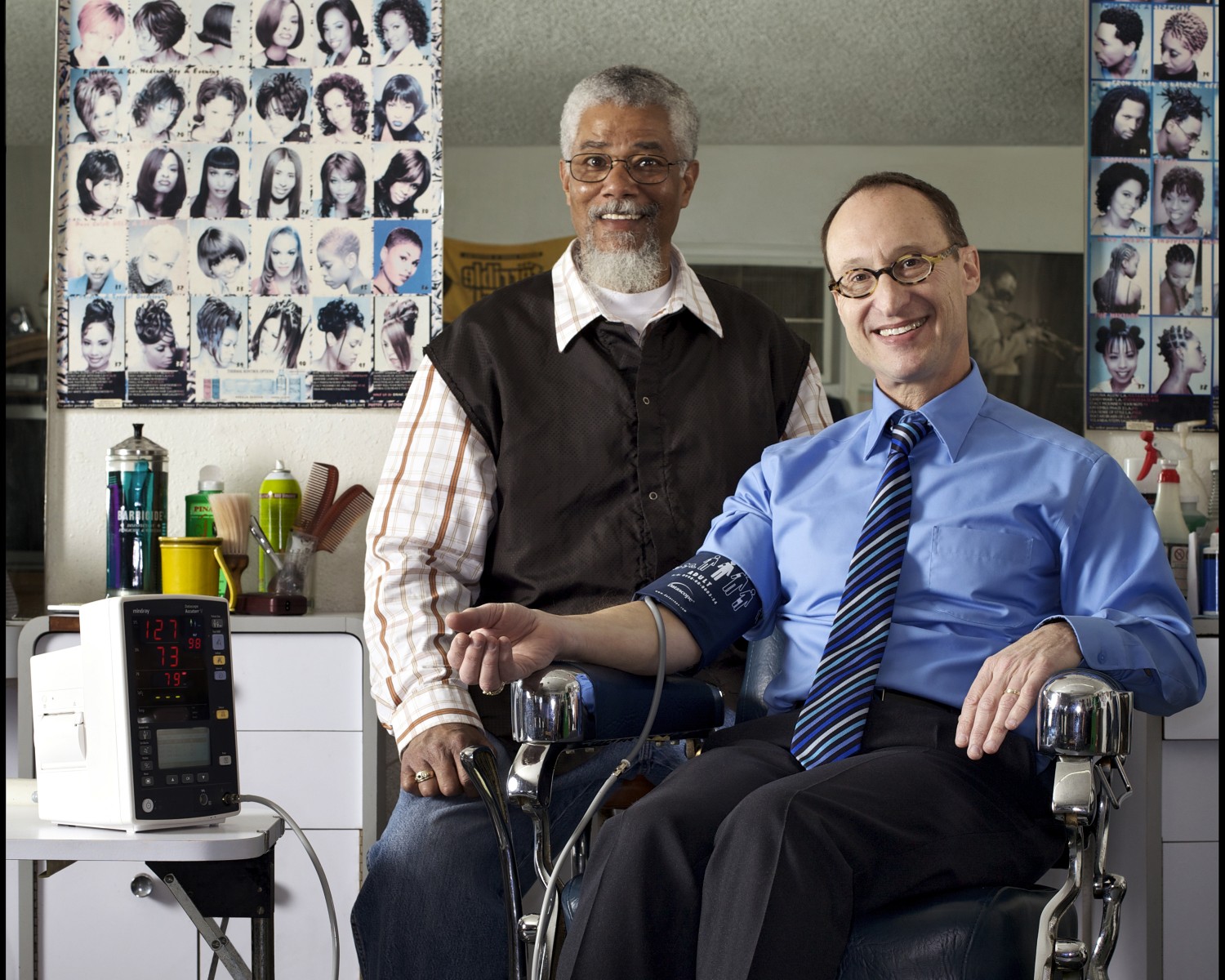As we celebrate Black History Month, I am reminded of one experience that had a profound impact on my view of health access and the pharmacist’s role in addressing medication use quality through team-based care.
 |
|
| Barbershop owner Eric Muhammad. Photo: Misha Gravenor (via Cedars Sinai) |
In December 2016, I had an opportunity to travel to Los Angeles to spend a few days learning from barber Eric Muhammed, Dr. Ronald Victor, MD, and the healthcare team at Cedars-Sinai. Eric, Ron, several pharmacists, and their research team were working together to implement a barbershop hypertension project to address undiagnosed or sub-optimally treated hypertension in African American men.
Participating barbers received training on how to initiate the conversation and screen for high blood pressure. If the individual had undiagnosed or sub-optimally treated hypertension, the barber would then contact the pharmacist and connect them with the patient. The pharmacist performed an assessment, such as a comprehensive medication review, and managed the individual’s hypertension.
The prespecified primary outcome was systolic blood pressure. Secondary outcomes included diastolic pressure, rates of meeting blood-pressure goals, numbers of antihypertensive drugs, adverse drug reactions, self-rated health, and patient engagement according to a validated instrument. The results were not only statistically significant, but also applicable to practice improvement.
You might have read about this project, but I wanted to share some observations through our lens of medication use quality. Here are a few aspects of this project that make it unique and impactful:
- This initiative was driven by barbers. Eric, a barbershop owner, and his fellow barbers leveraged their accessibility and influence in the community to initiate health conversations with their clients. The barbers cared personally and deeply for their clients and their long-term health. And professionally speaking, although a bit direct, they shared with me that they could not give cuts if their clients passed away due to strokes and heart attacks. This honest take gave me greater insight into their investment in this project. A healthy community has intrinsic benefits – and it’s good for business.
- The clinical evaluation, prescribing, and medication management was led by pharmacists. The pharmacists were working in collaborative pharmacy practice agreements with physicians and members of the healthcare team to actively manage patients’ medication therapies and care, including prescribing and adjusting medications. By placing pharmacists directly in the barbershops, they were able to meet patients and provide care in a convenient setting. This project is a great example of leveraging pharmacists’ medication expertise in patient-centered, team-based care.
- This project leveraged technology and data to conduct research, measure outcomes, and demonstrate value. Blood pressure readings were automated, and readings were directly uploaded to a computer that electronically transmitted data to a secure website. Through mobile documentation stations located in barber shops, the pharmacists were empowered through technology and data to have critical conversations with patients, as well as triage care and communicate with the broader healthcare team in real-time. Access to data, especially in real-time, is a crucial to effective pharmacist-provided care.
- Patients who received care from a pharmacist met their health outcome goals! As noted by the Los Angeles Times, this study found that when a group of African American men with untreated high blood pressure got a screening from their barber, as well as a visit to the shop from a pharmacist, close to two-thirds of the men brought their blood pressure into a healthy range. Further, the research showed that, among black male barbershop patrons with uncontrolled hypertension, health promotion by barbers resulted in larger blood-pressure reduction when coupled with medication management in barbershops by specialty-trained pharmacists.
We often talk about the accessibility and convenience of pharmacists and pharmacies, but this project took accessibility a step further by imbedding pharmacists into the communities where patients were.
 |
|
| Barber Wally Riddle takes the blood pressure of Ronald Victor, MD. Photo by Cedars-Sinai. |
Dr. Victor was a champion for patient care and improving access through interventions which were team-based, pharmacist-led, and community-focused. He was one of the pioneers in proving that hypertension healthcare provided in convenient neighborhood settings could have a positive impact on the African American community, which has higher rates of hypertension, hypertension complications, and death. Sadly, he passed away in September 2018 after a battle with pancreatic cancer.
This project also shows how a great idea blossoms into a broader standard of practice. Thanks to Dr. Victor and the pharmacist champions at Cedars-Sinai, this work continues today. Through NashvilleHealth, Vanderbilt, CVS-Aetna, and other partners, we were able to bring this project to Nashville in an effort to replicate the great results found through the research done at Cedars-Sinai.
This project is a prime example of what our healthcare system should strive to be: patient-centered, team-based, and outcomes-driven. Thanks to your efforts, PQA is solidly focused on solving critical public health issues through improved medication use quality, which involves leveraging the accessibility and expertise of pharmacists as members of the healthcare team, promoting health equity, and addressing social determinants of health.
Here are more details and results from the project:
- Researchers recruited 319 African-American men ages 35 to 71 years whose baseline systolic blood pressure was higher than 140 mm Hg from 52 Los Angeles County barbershops.
- Of the 309 men who completed the study, 132 were randomly assigned to receive monitoring and medication management from a pharmacist (intervention group) and 171 to receive encouragement from their barber on lifestyle recommendations and making doctor appointments (control group).
- After six months, 64 percent of men in the intervention group had blood pressure in the normal range, compared with just 12 percent of the control group. In the intervention group, systolic blood pressure decreased from 153 mm Hg at baseline to 126 mm Hg, and diastolic blood pressure decreased by 18 mm Hg. In contrast, in the control group, systolic blood pressure decreased from 155 mm Hg to 145 mm Hg, and diastolic blood pressure dropped by 4 mm Hg.
- At baseline, about one-half of participants in both groups were taking at least one blood pressure medication. After six months, 100 percent of those in the intervention group and 63 percent of those in the control group were taking blood pressure medications.
If you want to read more about the clinical results, see the NEJM article. You can also read the presentation of research to the American College of Cardiology.
